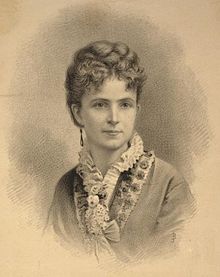Book review Tuesday: The 19th Wife, by David Ebershoff
My friend Karen recommended that I read David Ebershoff’s The 19th Wife, a novel focusing on, among other things, the apostasy from the Mormon Church of Brigham Young’s 19th wife, Ann Eliza Young. I find all things Mormon fascinating, so, despite being in the middle of no fewer than three other books, I downloaded The 19th Wife and read it in a few days.

First, a word about the structure of this book: it’s kind of confusing. Ebershoff makes use of fictional historical clippings, fictional memoir, fictional academic documents, and a fictional narrative set in the present day, mixing them throughout the book. There’s even a fictional introduction by Harriet Beecher Stowe to a fictional memoir by Ann Eliza Young. Complicating matters, Ebershoff based the principal historical narrative – the memoir of Ann Eliza Young – on her actual autobiographies (Wife No. 19 (1875) and Life in Mormon Bondage (1908)). I wish that Ebershoff had explained up front – perhaps in a preface to the novel – his reasons for structuring the book this way, because his explanation in the reader’s guide at the back of the book is helpful:
I decided to include a number of fictional documents or sources (many of them of course inspired by actual documents and sources) because I wanted to give the reader the sense of what it’s like to delve into this history and to sort through the record and different points of view. The novel’s historical sections focus on Ann Eliza’s story, but I wanted to enrich that in a way that re-creates, for the reader, the experience of digging deeper and deeper into the archives.
Mid-way into the book, the structure begins to make sense and it becomes easier to switch back and forth between the various characters’ perspectives. The two main narratives are: 1) Ann Eliza Young’s memoir, set in 1975, and 2) the present-day story of Jordan Scott, a twenty-one year old so-called “Lost Boy” who was thrown out of his polygamist community at age fourteen, and who has to return to his Utah hometown to help his mother, who has been accused of murdering his father. His mother, like Ann Eliza Young, is the 19th wife of her husband. Both narratives are compelling but I was more drawn to Jordan’s story, probably because modern-day Mormon fundamentalists are so creepily fascinating. During the historical narrative, on the other hand, I often found myself skimming or skipping over long (presumably fictional) soliloquies by Brigham Young or Joseph Smith about the purposes of the early Mormon church, and so on.
My other complaint with the book was that the dialogue in the modern-day story was often tortured. For example: Jordan is gay and has a one-dimensional, flamboyant gay friend named Roland who says things like “Kanab? Sounds Kanasty. Oh, honey, where on earth?” Sometimes the characters talk in ways that real people just do not talk. Here’s a dialogue between Roland and Jordan, in which Jordan is telling Roland he needs to go back to Utah to help his mother get out of jail:
“Look at her – her eyes, I mean. I need to see her. I’ll be gone a day or two, max.”
“Sweetie, before you get in that van of yours and drive all the way to Utah, can I remind you of two small but highly relevant facts? One – and I’m sorry to put it like this – your mom dumped you on the highway in the middle of the night when you were – what? – fourteen. Not a nice thing. And two, she just popped off your dad. Are you really sure a family reunion’s such a good idea?”
Yeesh. Luckily, the story was gripping enough that I wasn’t too distracted by the ridiculous dialogue. Ebershoff paints a really chilling portrait of life inside a fundamentalist LDS community, and he manages to draw the parallels between the early Mormon polygamists and modern-day fundamentalists in a sensitive way, partly by including perspectives from (fictional) modern day Mormon academics, who are appalled by polygamy yet nonetheless proud of their Church’s history. The book provides an interesting glimpse into Mormon history, the birth of polygamy, the lives of actual historical figures (Brigham Young, Joseph Smith, Ann Eliza Young), the consequences of apostasy from the LDS Church, and daily life for modern LDS fundamentalists. It covers a lot of ground without seeming too weighted down or dry. Recommended for historical fiction fans and/or those who are curious about Mormon fundamentalism.

Leave a Reply